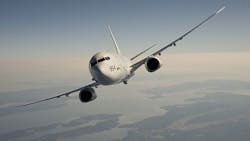Navy prepares to ramp-up production of P-8 Poseidon maritime patrol jets for U.S. and Australia
PATUXENT RIVER NAS, Md., 19 Aug. 2014. U.S. Navy surveillance aircraft experts are making plans to ramp-up production of the Boeing P-8A Poseidon maritime patrol jet for U.S. and Australian naval forces.
Officials of the Naval Air Systems Command at Patuxent River Naval Air Station, Md., awarded a $296.3 million contract last week to the Boeing Co. in Seattle for long-lead items for the 12 lot II full-rate production P-8 aircraft. Eight of the P-8s are the U.S. Navy and four are for the Australian military.
Long-lead items involve system components that require the longest time to build, which could delay overall system production if money isn't allocated for production early in the process.
The P-8 is a militarized version of the Boeing 737 single-aisle jetliner hardened for maritime patrol and anti-submarine warfare (ASW) missions. The P-8 is scheduled to replace the Lockheed Martin P-3 Orion maritime patrol turboprop aircraft.
Ultimately, the Navy plans to buy 108 P-8A aircraft from Boeing to replace the service’s fleet of 196 P-3C Orion maritime patrol aircraft, which are approaching the end of operational life. The P-3 is a version of the Lockheed Martin Electra four-engine turboprop aircraft.
Earlier this month Boeing delivered its 15th P-8A Poseidon to Navy Patrol Squadron 16 at the Jacksonville Naval Air Station, Fla., where it will help expand the Navy's long-range maritime patrol capabilities. The aircraft will help train Navy Poseidon crews in preparation for deployment. P-8s also will be based at Whidbey Island Naval Air Station, Wash.
The P-8A is a specially hardened and reinforced version of the Boeing 737 passenger jet, and is designed to operate at extremely low altitudes over the ocean during close-in searches for potentially hostile submarines. The P-8A is designed to withstand the rigors of low-altitude turbulence and exposure to salt spray.
Related: Raytheon to provide 13 more ocean- and land-surveillance radars for Navy P-8A patrol jet
Navy officials plan to use the P-8A in tandem with the Northrop Grumman RQ-4N Triton Broad Area Maritime Surveillance (BAMS) unmanned aerial vehicle (UAV) -- a maritime-patrol version of the Global Hawk long-range surveillance UAV. Plans call for using BAMS to detect potentially hostile submarines and surface ships, and upon detection, to call in the P-8A to take a closer look or to attack hostile vessels with torpedoes and missiles.
Boeing is building the Poseidon aircraft at its factory in Renton, Wash. The 737 fuselage and tail sections will be built by Spirit AeroSystems in Wichita, Kan., then transferred to Renton where all structural features are incorporated in sequence during fabrication and assembly.
The P-8A’s flight management system and the stores management system have been developed by GE Aviation Systems in Grand Rapids, Mich. (formerly Smiths Aerospace). The cabin has as many as seven operator consoles.
The Poseidon’s MX-20HD digital electro-optical and infrared (EO/IR) multi-spectral sensor turrets come from L-3 Communications Wescam in Burlington, Ontario. The MX-20HD is gyro-stabilized and can have as many as seven sensors, including infrared, CCDTV, image intensifier, laser rangefinder, and laser illuminator.
Related: Navy orders 16 Boeing P-8A maritime patrol jets, as program reaches full-rate production
The aircraft has the upgraded APS-137D(V)5 maritime surveillance radar and signals intelligence (SIGINT) system from the Raytheon Co. Space and Airborne Systems (SAS) segment in McKinney, Texas.
The APS-137D(V)5 radar, which is installed on the P-8’s enlarged nose fairing, provides synthetic aperture radar (SAR) for imaging stationary ships and small vessels, coastal and overland surveillance, and high-resolution imaging synthetic aperture radar (ISAR) for imaging surfaced submarines and fast surface vessels operating in coastal waters.
The P-8A will have the CAE Inc. advanced integrated magnetic anomaly detection (MAD) system. The Navy plans to arm the P-8A with the MK 54 torpedo.
On this contract Boeing will do the work in Renton, Wash.; Baltimore; Greenlawn, N.Y.; the United Kingdom; and North Amityville, N.Y., and should be finished in April 2018.
For more information contact Boeing online at www.boeing.com/boeing, or Naval Air Systems Command at www.navair.navy.mil.

